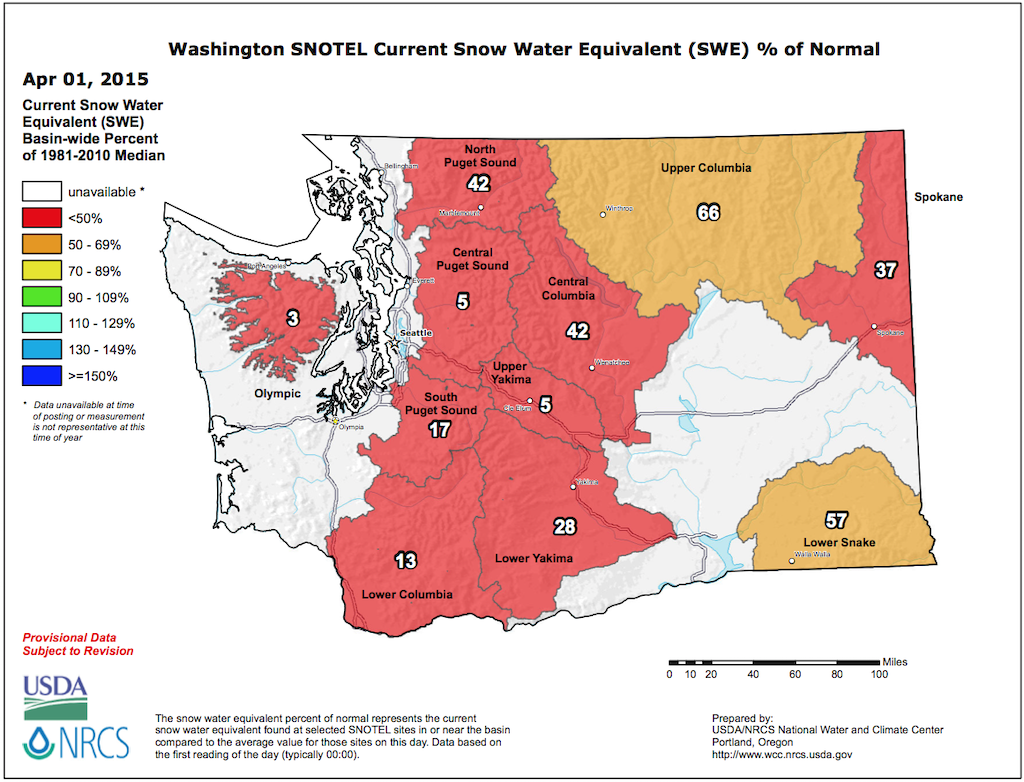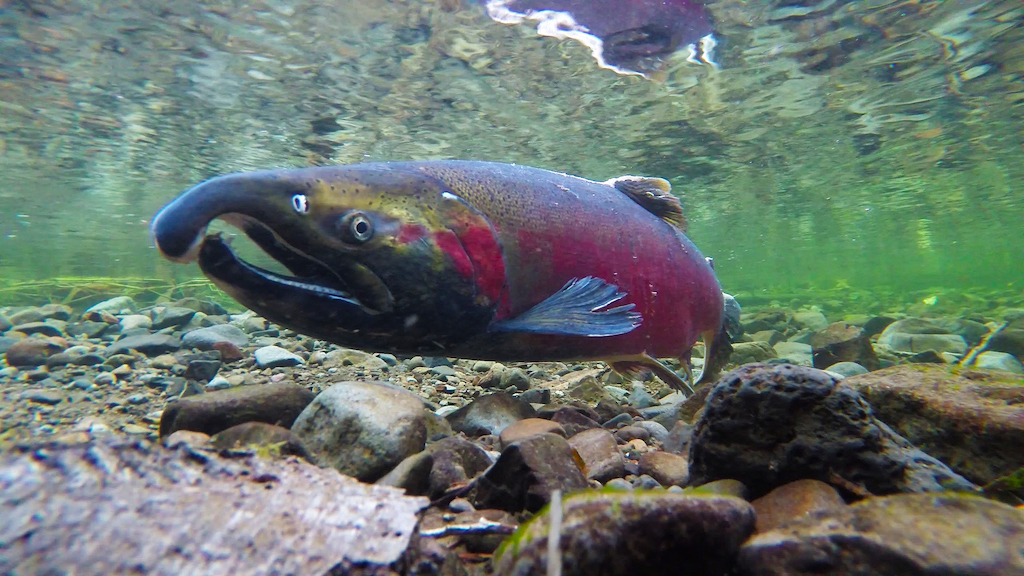Read through the journal entries of early visitors to the Puget Sound region and it’s clear they were impressed with the snow-clad mountains. In a May 1792 description of Mount Rainier, Peter Puget wrote: “The Snow was yet, notwithstanding the Heat more than 2/3 down & its Summit perfectly white appeared to reach the clouds.” Forty-nine years later on the first American expedition into Puget Sound, seaman Joseph P. Clark marveled at the mountains covered “with everlasting snow…a striking contrast to the valleys near the sea, which are covered with verdure.” And, in 1853, a young, pre-Civil War George C. McClellan noted “A good view of the Olympic Range…they, as well as the Cascade Range, are well covered with snow.”

Climate models project that if carbon emmisions continue as they are now, the vast majority of watersheds feeding Puget Sound will receive more rain and far less snow by 2080, causing increased flooding and other dramatic changes to the freshwater ecosystem. We look at the past and possible future of the region's snowpack and what this might mean for salmon and other species — including humans.

If they had arrived in the winter of 2015, particularly in late spring, these men may have had far different impressions. That year, warmer than normal temperatures had more often brought rain instead of snow to the higher elevations: On April 1, the date researchers have established as a standard of comparison, the mountains held a near record low snowpack.
When scientists carefully measured what they called the snow water equivalent (SWE), or amount of water contained within the snowpack, the numbers were five to 42 percent of normal, and, in the Olympics only three percent. Instead of the scenery that previous generations had enjoyed, the mountains had lost their lovely mantle of snow, as well as the benefits that melting snow provides to the Puget lowlands.

Map of Washington showing snow water equivalent measures on April 1, 2015. Map: USDA/NRCS
The snow drought
The effects of the 2015 “snow drought,” as researchers call the low snowpack, were immediately clear. There were warmer streams and rivers carrying less water, which resulted in crops with reduced yields and the death of 1,647,000 juvenile salmon, steelhead, and rainbow trout at 11 state hatcheries. Not only did the salmon suffer that year, the effects rippled through subsequent generations. The warm, low flows led to fewer eggs hatching, more predation of juveniles, and less fit adults heading into Puget Sound’s marine waters. The salmon struggled in part because their life histories, or adaptions to the specific conditions in their natal stream, made them more susceptible to change than many other organisms. (A project by the Tulalip Tribes that is actively trying to address these issues involves relocating beaver to the Skykomish River watershed, where their dams create habitat—deep pools and slower moving side channels—beneficial to salmon.)

Coho salmon spawning on the Salmon River. Photo: BLM (CC BY 2.0)
Perhaps an anomaly at present, the 2015 conditions were considered by many to be a dress rehearsal for the future. “They will be the normal conditions in another fifty years,” says James Rufo-Hill, Climate Science Advisor for Seattle Public Utilities (SPU). “I can’t imagine what below normal will be like.” The effects, experts say, will play out in drinking water, flooding, fire, hydropower, agriculture, and wildlife.
“Warm snow”
Historically, the Puget Sound rainy season began in October, when the rains returned after the dry summer months. As fall and winter progressed, precipitation turned primarily to snow in the mountains and started to build the snowpack, which would accumulate until about April 1, when the snow would start to melt, enter streams, and flow into the Sound. With climate change, however, the snow window has started to close with snow melting earlier because of spring warming. Researchers project that the maximum amount of water in the snowpack will occur 20 to 40 days earlier by the 2080s. The models further show that the greatest decreases for this maximum are at elevations between 1,000 and 1,400 meters; above, the temperatures remain below freezing despite climate change, and below, little snow accumulates.
Harriet Morgan, a climate researcher at the University of Washington’s Climate Impacts Group, refers to our snow as “warm snow” because it forms and persists right around the freezing point. “This means our snow is hypersensitive to any temperature rise,” she says. This is crucial, she adds, because the majority of our streams are fed by a combination of snow and rain. (If greater than 40 percent of winter precipitation falls as snow, the stream is snow dominant; at the opposite end are rain-dominant streams.) Climate models project that by 2080 the vast majority of watersheds feeding Puget Sound will be rain dominant, which will result in increased flooding, earlier spring stream peaks, and reduced summer minimum lows.
In these scenarios, it is not just salmon that will feel the sting of a changing climate. Humans depend on the snowpack too.

Aerial photo of flooding in Lewis County, WA. Photo: WSDOT (CC BY-NC-ND 2.0)
“What I worry about is that we have long operated around embedded climate assumptions,” says Morgan. The size of bridges and culverts. The location of roads. Crop irrigation. Floodplain management. How we think about all of these issues is dictated by historic climate patterns and those numbers are becoming less valid year by year. For example, Morgan notes that models show that by the 2040s the stream flows associated with 100-year floods on the Skagit River will occur every 22 years, and 30-year floods will strike every 7 years. “If we don't adjust the assumptions that are pretty pervasive across these systems the climate impacts we experience will be more severe than if we take the time to expose these unexamined assumptions and adjust the systems accordingly.”
Side note: What about the glaciers?
Although Mount Rainier has lost more than 20 square miles of glacial and perennial ice (about 39 percent of its total) and the North Cascades and Olympic National Parks have experienced even greater losses—more 50 percent reduction in ice in each park—since 1900, the glaciers are not predicted to vanish any time soon. At least at higher elevations such as on the volcanoes. Lower down though, the ice is expected to be greatly diminished by 2100, says Jon Riedel, glacial geologist at North Cascades NP.
With shrinking glaciers comes increased flooding, primarily because the less ice that covers the ground, the more surface area available for runoff. More open ground then makes the problem worse because the darker soil and rock warms more readily than white ice, which leads to warmer temperatures and more melting. And because the glaciers feed so many lowland streams, the ripple effect of their loss will spread all the way down to salt waters, adds Riedel.

Comparison photos show thinning and retreat of the Blue Glacier, Olympic National Park, WA. Photos: NPS
Read more about thawing glaciers in the new “Shifting Snowlines and Shorelines” by the Climate Impacts Group at the University of Washington.
Drinking water
Adapting to the new climate conditions is a prime concern for Rufo-Hill and his SPU colleagues, particularly in regard to the reduced snowpack and its effects on drinking water. Seattle has two sources of water, the Tolt River and Cedar River watersheds, both of which are within the zone of greatest loss of available water due to declines in the snowpack. Each watershed contains a dam, used to create a reservoir that stores the city’s drinking water. SPU also relies on snowpack, or what Rufo-Hill calls the “third reservoir.” It plays a critical role in the system by acting like a sponge and slowly releasing water when it is most needed, in the parched summer months.
Not only does SPU have to worry about the shrinking snowpack, and the expected loss of this water source—researchers project that by 2080 the third reservoir might not exist because of anthropogenic warming—they also have to worry about the changing precipitation season. Historically, SPU would leave room in its reservoirs to provide a “pocket” for flood management, which led to smaller floods because the water remained behind the dams and didn’t overwhelm the riparian environment. With climate warming, however, managers will have to balance the need to save as much water as possible given that the third reservoir will be empty. “It’s like having too much and not enough water at the same time,” says Rufo-Hill.
Flooding is only expected to become more profound in the future because of heavier rains and increased areas of runoff due to a higher snowline. One study projects that by the 2080s, 100-year floods in Puget Sound will carry between 12 and 55 percent greater flows. More water means a greater ability to erode and an increased risk of landslides, both of which generate increased sediment loads. When this material ends up on stream beds, it reduces the carrying capacity of the river and leads to greater flooding. Of equal concern, if the sediment is fine enough, it can smother and cut off the supply of oxygen and food to salmon redds, or the stream bottom depression where salmon lay their eggs. The sediment can also fill in interstitial spaces between cobbles and boulders that had provided a safe haven for young salmon.
Morgan says that flooding will also become more problematic because rising sea levels will make it more difficult for rivers and streams to drain into the Sound. As a result, floodplains close to saltwater will experience deeper, more widespread, longer lasting floods.
Warming temperatures and reduced snow cover also translates to increase fire potential, which is particularly problematic for Rufo-Hill. Part of what makes Seattle’s drinking water special is the pristine nature of the Cedar River Watershed. Unlike most large cities, Seattle entirely owns its primary drinking water source, which means no residential, commercial, or industrial development. Because of the environmental conditions, SPU is unique in the country in not having to filter its water. If a large enough fire hit the watershed, SPU could conceivably have to implement a filtration system, which takes time and money. “This could mean the temporary loss of the Cedar River water, or about 70 percent of Seattle’s drinking water,” says Rufo-Hill.
“I think that people understand how climate change affects trees and animals, but they find it harder to wrap their heads around how society is affected,” says Morgan. They understand that ski seasons are getting shorter and perhaps see campgrounds that had not previously been flooded but they may not understand the additional transformations that are coming. “We are experiencing a change in the fundamental characteristics of our hydrology. We are going to have more water in winter when we don’t need it and less water in summer when we do.”
Adapting and preventing
Rufo-Hill thinks that the lack of concern can be blamed in part on how the issue has been framed. During past drought conditions, the urban centers of Puget Sound often got depicted as not experiencing the droughts. “There’s this cognitive dissonance that Seattle and Tacoma and Everett are somehow not part of the ecosystem and have enough water,” says Rufo-Hill. “People need to realize that we may have enough right now but it’s going to keep getting harder and harder to provide water, particularly if people don’t recognize that the water cycle involves plants, animals, and themselves.”
Rufo-Hill and Morgan both stress that the projections are just that— projections. We cannot stop the changes that are occurring, because the warming is “already in the pipeline,” says Morgan, but if we can act immediately and rapidly scale up the reduction of CO2 emissions, we have the opportunity to reduce the climate impacts. If we care about future financial, ecological, and societal problems, she says, there is little recourse but to act.

